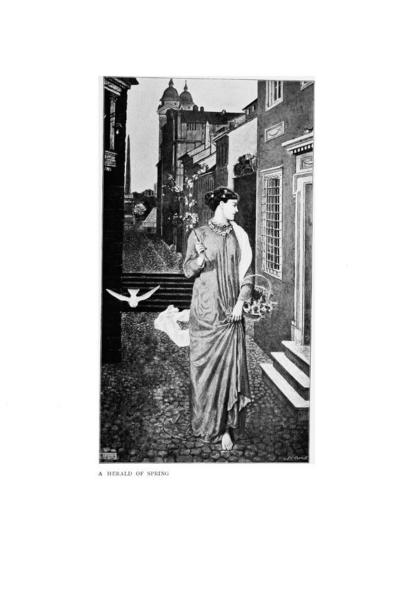あめんどう Almond――「春を告げるもの A Herald of Spring (Walter Crane)」のつづき [Marginalia 余白に]
「春を告げるもの A Herald of Spring (Walter Crane)」のつづきです。
前に参照したコノディーの『ウォルター・クレインの芸術』(ロンドン、1902) The Art of Walter Crane という本を見たら、ウォルター・クレインのローマ滞在について、つぎのような記述がありました。――
His journey to Rome in 1870 could not fail to mark an important phase in the development of Walter Crane's art. He steeped himself in the study of the masters of the Renaissance, whilst the beauty of Italian scenery and southern sunshine inspired him to a series of landscape studies, which must be counted among the finest productions of his fertile brush. The temperament revealed by these delightful water-colours is sunny and joyful throughout. He never strikes the note of sadness, so often to be found in pictorial representations of the Campagna and of the ruins in and around Rome. There is hope for him in every ruin. His sky is ever smiling, the glooms of the ruins counteracted by the cheerful signs of spring, the youthful green of the meadows, the delicate pink of the blossom-covered almond trees. Were it not for the characteristic glimpses of Italian architecture and the distinctly southern vegetation―lemon and orange trees, cypresses, olives―one might almost think of peaceful English scenes. A number of these water-colour drawings were shown between 1870 and 1876 at the annual exhibitions of the Dudley Gallery, the most important one being "The Herald of Spring," a graceful maiden in a clinging robe of primrose hue, carrying a spray of almond blossoms, and stepping airily along a typical Roman street. The colouring is extremely delicate and suggestive of early spring, the drawing as exact and conscientious as that of all true pre-Raphaelites. (p. 94)
(1870年のローマ旅行はウォルター・クレインの芸術の展開における重要な局面を刻むこととなった。ルネサンスの大画家たちの研究に没頭したようだが、同時に、イタリアの風景美と南方の陽光に触発されて描いた一連の風景画の習作は、クレインの豊穣な絵筆が生み出した最上の作品となっている。これらの水彩画があらわにする気質は、一貫して太陽のように陽気で喜びに満ちている。一般にカンパーニャ平野やローマ市内外の廃墟を画家が絵で描いた場合、しばしば悲哀の調子が見られたが、クレインの場合は異なる。空は微笑みつづけ、廃墟の陰鬱は、春の陽気な兆しや草原の若々しい緑や、花に覆われたアーモンドの木の繊細なピンクによって抑えられている。イタリア建築が特徴的に垣間見られたり、典型的な南の植生――レモンやオレンジの木、セイヨウヒノキ、オリーヴ――が見られなかったなら、平和なイギリスの風景だと思う人がいてもおかしくはないだろう。水彩画の数点は、1870年から1876年にかけてダドリー・ギャラリーの年次展に出品された。そのなかで最も重要なのが "The Herald of Spring" である。春を告げるのはプリムローズ〔淡黄緑色〕のローブをまとった優美な乙女、アーモンドの花の小枝を手に持ち、典型的なローマの街路を空気のように歩んでいる。色彩はきわめて繊細で、初春を想起させる。筆致は真のラファエロ前派がすべてそうであるように精確で入念である。)
ということで、桜にも桃にも見えた花はアーモンドでした。Konody は神話的なレファレンスみたいなものを何も書いておらないのですけれど、ウォルター・クレインが(五月柱も含めて)春の絵をたくさん描き――The Advent of Spring とか The Coming of May (あ、この2枚同じか (1873)) とかA Day of Spring: View from Monte Pazioli towards Albano とか The Earth and Spring とか La Primavera とか Signs of Spring とかThe Triumph of Spring とか、詩画集 The First of May: A Fairy Masque とか、(そして春の女神でもあるペルセポネ=プロセルピーナを好んで描いてもおり)――それがときに神話の枠組みをもっていることを考えるならば、この、妻をモデルにしたという裸足の「乙女」は、ペルセポネのイメジをもっているのではないかと思われます。そこで手篭の中の花のダフォディルもかかわるかなあと。しかし、ややこしくなるので、それはまたいずれ。

The Art of Walter Crane, between pages 94-95
で、アーモンドですけれど、調べてみても、とりたてて神話的象徴性をもってはいないみたいです。日本語のウィキペディアの「アーモンド」も英語のWikipedia の "almond" も、旧約聖書におけるアーモンド(古い日本語訳聖書で「あめんどう」)の言及を説明して、それはそれなりに象徴みたいなところもあるのですけど。どうやら、実際にローマの春の風景に見られたアーモンドの花をクレインは入れたのかなあと思われたのでした。
////////////////////////
「アーモンドのおはなし 5 アーモンドの花」 <http://www.ezaki-glico.com/almond/flower/index.html> 〔江崎グリコのページ〕
「さだまさし 春告鳥 - Ichishuのさだ作品批評シリーズ(第1弾)」 <http://www008.upp.so-net.ne.jp/ichishu/sada/harutsuge.htm> 〔いえ、ちょくせつ関係ないですけど、メモ的に。春告鳥はウグイスです。春告魚はイワシ〕
以下再掲
Walter Crane Catalogues:
1) "Catalogue of Books Illustrated or Written by Crane" Walter Crane - Arts & Crafts Home <http://www.achome.co.uk/waltercrane/index.php?page=catalogue> 〔The Arts and Crafts Home: A Design Source for Home Decoration 内〕
2) A Bookman's Catalogue: The Norman Colbeck Collection of Nineteenth-Century and Edwardian Poetry and Belle Lettres, Vol. 1 A-L (University of British Columbia Press, 1987), pp. 175-7 <http://books.google.co.jp/books?id=4DUL-RazzhgC&pg=PA175&dq=A+Bookman%27s+Catalogue+Walter+Crane&as_brr=3&ei=0H7_SoHaHpOilQTelvTyDg#v=onepage&q=&f=false>
Walter Crane Images:
1) "Walter Crane Image Gallery" <http://www.artmagick.com/pictures/artist.aspx?artist=walter-crane> 〔ArtMagick〕
2) "Walter Crane Online" <http://www.artcyclopedia.com/artists/crane_walter.html> 〔Artcyclopedia: The Guide to Great Art on the Internet〕
3) Walter Crane, A Floral Fantasy in an Old English Garden (New York and London: Harper, 1899) <http://www.archive.org/stream/floralfantasyino00cranrich#page/n7/mode/2up> 〔Internet Archive〕
4) -----, A Flower Wedding: Described by Two Wallflowers (London: Cassell, 1905) <http://www.archive.org/stream/flowerweddingdes00cran#page/n5/mode/2up> 〔Internet Archive〕
5) -----, illustration. Nathaniel Hawthorne, A Wonder Book for Girls and Boys (Boston: Houghton Mifflin, ) <http://www.archive.org/stream/wonderbookforgir00hawt2#page/n11/mode/2up> 〔Internet Archive〕
6) Paul George Konody (1872-1933), The Art of Walter Crane (London: G. Bell and Sons, 1902) <http://www.archive.org/details/cu31924014894558> 〔Internet Archive〕




ともちん さま、niceありがとうございます。
by morichanの父 (2011-02-19 09:05)
kaoru さま、ご訪問とniceありがとうございます。
by morichanの父 (2011-02-19 09:06)